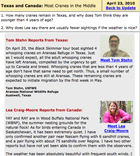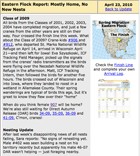The "St. Marks Two" who left FL April 14 completed their migration April 21! Wearing mini GPS devices, so did RAY and YAY; what did researchers learn? A scientist helps us explore how many eggs it takes to make another Whooping crane egg, and another wonders how cranes know when they're home. What do you see in this photo—and what don't you see?
Today's Report Includes:
- Migration News: Map and Field Reports
- RAY and YAY: Migration Complete!
- Audio Clip: How Do Cranes Know "Home"?
- Journal Topic/Lesson: Eggs to Cranes
- Earth Day: A Podcast
- Links: Helpful Resources to Explore
Image of the Week
 Western Flock News |
 Data /Map |
 Eastern Flock News and Finish Line |
|
Many more whoopers were seen in the Dakotas as they reached the halfway point of migration, and YAY and RAY are back at the Canada nesting grounds! |
|
The last two juveniles (#906 and #912) to leave St. Marks NWR passed over Necedah NWR on April 21! Where are they now? What's Sara's latest nesting news? More. |
You've learned that cranes normally lay two eggs. As we look forward to those eggs to hatch, here's something to wonder:
- How many Whooping crane eggs does it take to make another Whooping crane egg? What factors might affect breeding success?
Write your thoughts. Then dig into biologist Brian Johns' lesson to discover more about the answer. Why don't the numbers add up? The answer is not as simple as it seems.
Did you know? On the 39th Earth Day (one year ago) the US House of Representatives passed the Crane Conservation Act. The Act supports crane conservation both in the U.S. and around the world. Cranes are considered the world’s most endangered bird family.
April 22 was the 40th Earth Day, and that's something to celebrate. "The idea of Earth Day hasn't changed, but the planet has," says Mark Chenoweth of Whooper Happenings, who aired his own Earth Day Podcast. One person CAN make a difference, and Mr. Chenoweth tells families how. He also reminds us, "You can't save a species unless you save their habitat and the environment they live in." Hear comments of Operation migration pilots, too, as we appreciate and celebrate all the efforts to help this endangered species.

Hear Mark
Chenoweth's podcast (9 min.) about Earth
Day and how our families can help the environment and help Whooping
cranes. Feel proud to do your part!
- Teachers/Overview: About This Study
- Image of the Week: What can you tell and what will you learn?
- Field Report: Western Flock
- Field Report: Eastern Flock
- Audio Clip: How Do They Know When They're Home?
- Lesson: How many whooping crane eggs does it take to make another whooping crane egg?
- Mapping and Record Keeping: Track the Migration
- Making Good Sightings: Official WCEP Reporting form
- Record Keeping: Arrival Log for Eastern Flock
- Journal: Downloadble Journey North Journal Pages
The Next Whooping Crane Migration Update Will Be Posted on April 30, 2010.






